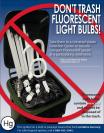Governor Shumlin Signs Mercury Lamps Bill
On May 19th, Gov. Shumlin signed the Mercury Lamps Bill, which will establish a recycling program for light bulbs that contain small amounts of mercury. We all know the benefits of fluorescent bulbs. They save energy and reduce greenhouse gas emissions. However, they also contain mercury which makes the need for effective light bulb recycling programs crucial.



